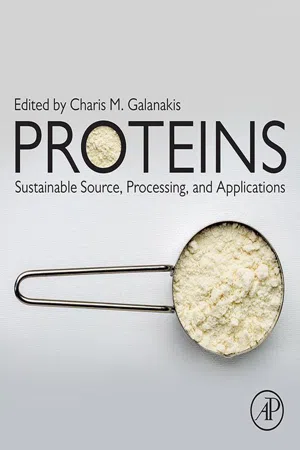1.1 Introduction
Livestock provides a quarter of all the protein (and 15% of energy) consumed in food, but also creates substantial environmental impacts (FAO, 2012; Herrero et al., 2016). The area of global pasture is more than twice that of cropland, with livestock animals additionally consuming around one-third of the crops harvested as feed (FAO, 2006). Despite rises in crop yields and in the efficiency of livestock production, global agricultural land area has been expanding, increasing by 464 Mha between 1961 and 2011 (Alexander et al., 2015). Land use change in recent decades has accounted for 10%–12% of total anthropogenic carbon dioxide emissions, and one-third since 1850 (Houghton et al., 2012; Le Quéré et al., 2015). Livestock production also contributes to atmospheric greenhouse gas (GHG) emissions, due to methane from enteric fermentation (presently 2.1 Gt CO2 eq/year; Gerber et al., 2013), and nitrous oxide emissions from fertilizer use on pasture and croplands in fodder production (Smith et al., 2014). In total, livestock is responsible for 12% of global anthropogenic GHG emissions (Havlík et al., 2014). A larger global population consuming a diet richer in meat, eggs, and dairy (Popkin et al., 1999; Keyzer et al., 2005; Kearney, 2010; Tilman et al., 2011; Bodirsky et al., 2015) has meant that agricultural land use change in the past 50 years has been dominated by the expansion of livestock production (Alexander et al., 2015). Besides the direct GHG emissions, agriculture also has large indirect emissions (e.g., from agrochemicals production and fossil fuel usage) (Smith and Gregory, 2013). The combination of land use change and other emissions increases the share of agriculture in all global anthropogenic GHG emissions to between 17% and 32% (Smith and Gregory, 2013). Therefore changing demands on agricultural production, and in particular for animal products (i.e., meat, milk, and eggs), has the potential to substantially alter GHG emissions (Bustamante et al., 2014; Havlík et al., 2014). Additionally, the sparing of agricultural land would provide options for further climate change mitigation measures, including afforestation or bioenergy (Humpenöder et al., 2014; Henry et al., 2018).
The projected rise in global population and higher per capita rates of animal product consumption, arising from higher incomes and urbanization, suggests that livestock production will continue to increase (Tilman et al., 2011). Changes in production practices and animal genetics that increase efficiencies may help to offset some of the potential land use and associated environmental impacts (Le Cotty and Dorin, 2012; Havlík et al., 2014). Substantial research attention has been given to supply-side responses, including expanding land in agricultural use and increasing food yields, especially crops (e.g., closing the “yield gap” or “sustainable intensification”) (Foley et al., 2011; Mueller et al., 2012; Kastner et al., 2014; West et al., 2014); or the potential benefits and trade-offs associated with increasing livestock intensities (Davis et al., 2015; Herrero et al., 2016; de Oliveira Silva et al., 2017). Nevertheless, demand-side measures to reduce animal product consumption may be necessary to meet climate change targets (UNFCC, 2015; van Vuuren et al., 2018), while helping to achieve food security (Smil, 2013; Bajželj et al., 2014; Meadu et al., 2015; Lamb et al., 2016). High levels of meat consumption are also detrimental to human health, with links to obesity, cardiovascular diseases, and cancer (Popkin and Gordon-Larsen, 2004; Hu, 2011; Bouvard et al., 2015; Cesare et al., 2016). Despite both the health and environmental benefits, changing consumer preferences toward a low meat diet is difficult because of cultural, social, and personal associations with meat consumption (Graça et al., 2015; Macdiarmid et al., 2016). Although there is some evidence for increasing rates of vegetarianism and reduced meat diets in western countries (Vinnari et al., 2010; Leahy et al., 2011), the global average per capita rate of animal product consumption has continued to increase (FAOSTAT, 2015a).
Analyses of the sustainability of the food system that do consider dietary changes tend to do so through an exogenous wealth-based factor, and anticipate continuations of current dietary trends (Schmitz et al., 2014; Engström et al., 2016a). However, diets and the food preferences that shape them do not necessarily follow fixed trends. Instead, they alter over time, influenced by technology, policies, and changes in social norms (e.g., Hollands et al., 2015). Modeling work has been done to project the impact of alternative assumptions regarding future diets (Stehfest et al., 2009; Popp et al., 2010; Haberl et al., 2011; Bajželj et al., 2014), and the ability of the agricultural system to supply the global population with a diet containing adequate calories has also been considered (Cassidy et al., 2013; Davis et al., 2014). Further studies in this area have taken a life cycle analysis (LCA) approach that typically consider either GHG emissions, energy or water requirements for individual commodities (Carlsson-Kanyama and González, 2009; Marlow et al., 2009; González et al., 2011; Pelletier et al., 2011).
Studies of the food system that include the impact of dietary change typically assume th...
